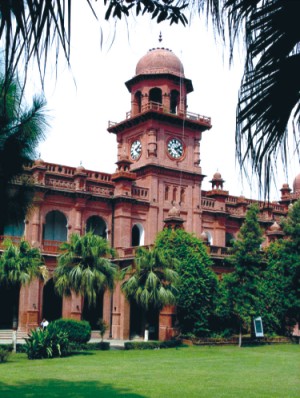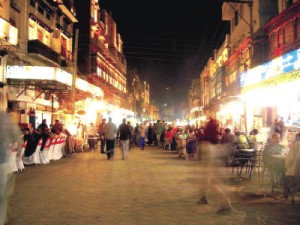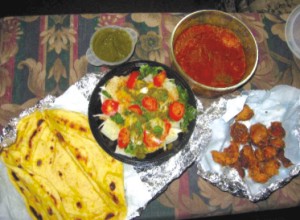| In Retrospect
Lahore’s Eateries of the Sixties
Ziauddin Choudhury
 |
Lahori Gate, one of the famous entrances
to the walled city.
|
In the fall of I964 two of my friends and I landed in Lahore, Pakistan, as part of the Pakistan Government's student exchange programme between the two wings. We were among ten or so students selected from then East Pakistan to study in different academic institutions in Lahore. We three Shafiq, Tawfiq, and I were destined for the Punjab University for our graduate studies, albeit in different subjects. Our common bond was, however, a friendship from our young days, and our common alma mater Dhaka University, where we had done our undergraduate studies. But an overriding bond all through the years had been created by our love for food, particularly for Shafiq and myself. With Shafiq leading, and myself in tow (and occasionally Tawfiq), we would venture into the new city to indulge in our love for food and eateries that we discovered through our friends in Lahore or sometimes through sheer serendipity. The eateries of the sixties in Lahore may not be there anymore, but the memory of the food they purveyed still exists; I can even smell the aroma even after four decades.
Our first introduction to the food of the historic city came through street foods, more precisely through breakfast foods eaten by the denizens of old Lahore, commonly known as the walled city. The walled city, or the inner city, dating back to Mughal days, had thirteen entrance gates or Darwazas, the most famous of which were Bhatti Gate, Mochi Gate, Shahalami Gate, Lahori Gate, and Delhi Gate. The gates that served as control points for entry to the city in olden days later became concentration points of sellers of consumer items, particularly food vendors. Our first introduction to street food in the walled city near Bhatti Gate was breakfast sold in one corner of the Gate. The most common items were paratha fried in pure ghee, paya (beef trotter soup), and gajar (carrot) halwa cooked in milk and ghee. This came along with lassi and milk tea. The parathas and the paya were cooked in open fire, right in a shack near the sidewalk, and people lined up from early morning to savour the offerings. We devoured the food offered in enamelware with great delight completely ignoring the insanitary environment where the food was being prepared and health hazards the food posed. These artery-busting foods were the most popular breakfast items that period in inner Lahore.
Our next street food venture would be fried fish, believe it or not. This happened because, a newly found Punjabi friend from our hostel, believed that for us Bengalis fish was a staple, and he wanted us to know that Lahore was the place for fish. The places that our friend took us for fish were Mozang Chungi, and Gawalmandi both near the famous Anarkali bazaar. Of the two, Gawalmandi was the most famous place for street foods (and I believe it still is). The fish that we ate in both places was known as Punjabi fish large slices heavily spiced and deep-fried. The fish was served in paper plates piping hot.
 |
Food street in Gawalmandi. |
After acknowledging our gratitude to our friend for sating our hunger for fish (because he thought so), we asked his indulgence to delve into other culinary delights that Gawalmandi had to offer. To indulge in those delights which were countless, we would make weekend forays to the Gawalmandi food street. Among the heavenly delights that we discovered were boti kababs made of kaleeja and gurda (liver and kidney), chapli kebab (coarse ground beef patty spiced with chilli and onions), chicken tikka, nehari (made with lamb shanks), and fruit chaat. The entire street (as also other streets in Lahore) would also be littered with the ubiquitous juice stands. Typical among the juices were Malta (orange) juice, Anar (pomegranate) juice, and sugar cane juice. The juice was freshly squeezed for every order and served in opaque glasses. One glass of orange juice was half a rupee only!
The first restaurant that we visited after our arrival in Lahore, however, was Cheney's Lunch Home, a place near Anarkali Bazar, not too far from the Punjab University Old Campus off Mall Road. It was the second day of our arrival, and three of us had gone to Anarkali Bazar to buy some clothing and basic supplies for our hostel living. The Bengali friend who took us for shopping was somewhat senior to us in terms of Lahore experience (he had been to Lahore before), and when he suggested the name of the restaurant for lunch we took it to be a Chinese restaurant. (He had pronounced Cheney's as “Chinese”.) To our dismay, (but delight later, with the food that we ate), we found that the dig served local food. We had brain curry, chicken korma, lamb kofta, and tandoor bread for lunch. What a delicious lunch that was! We thanked our friend, and ourselves that the place did not turn out to be a Chinese restaurant after all. We would return to the restaurant whenever we could.
In no time we would discover that Lahore had many more restaurants than we had seen in Dhaka, some of which were actually beyond our reach. Of necessity we had to limit our food and eateries exploration to the ones near our reach, and food of Gawalmandi and Mozang Chowk. But soon we tired ourselves of kabab and street food, and were longing for some rice and curry that were really a rarity in Lahore those days. In the campus mess hall our daily menu consisted of roti and some badly cooked meat lost in a heap of vegetable mash and covered with flowing oil. Again, our Punjabi friend Shafqat came to our rescue (to whom we had actually stuck like satellites).
Two restaurants that he took us to in search of rice and curry were Rachna and Shezan Oriental both near the Old Punjab University campus. Rachna had fixed price menus at three levels. The lowest, priced at two rupees, offered a vegetable, a lamb curry, and rice cooked with butter (ghee). The most expensive dish priced at five rupees pompously called Sultani Lunch offered a shami kabab, a chicken curry, a lamb curry, rice and a pudding. My friend Shafiq was a frequent patron of this eatery.
Shezan Oriental was slightly more expensive, and it was patronised by the intellectuals of Lahore (poets, college professors among them). It had a long menu, all very appetising. Our special focus was always on getting some rice (again cooked in butter), and some curry. Shezan's lassi was out of this world.

The fancy restaurants of our time that period, however, were all located in Upper Mall Road. The names that immediately come to my mind are Shezan Continental, Gardenia, and Lords, which catered to a more wealthy and deep-pocketed clientele. All the restaurants were air conditioned, and very elegantly furnished. The food was a mix of continental and Pakistani cuisines. It is not that we did not set foot in those upscale digs. Once in two months or so we would visit one of these establishments and blow away about a quarter of our monthly allowance indulging in the extravagance. Shezan Continental had its specialty sandwiches and its signature soft drink – house made fresh lime. Sometimes we would order only a glass of chilled fresh lime (costing only a rupee), and hold on to it for an hour of air-conditioned comfort. Gardenia was more expensive, and I think we went there only twice. Food was mainly continental, with eye-popping prices. Lords was a teatime favourite of Lahore intellectuals. The most notable among the accompaniment for tea there was its confectionery that included various pastries, and chicken or mutton patties.
This tribute to Lahore eateries would not be complete without paying homage to the Tuck Shop (food stall) in the backyard of our Hostel in the New Campus near Ravi canal. Called Shezan Sentimental by my friend Shafiq, the place was run by a father and son from Peshawar. This was the only place for breakfast or snacks within a mile of our newly constructed hostels. A typical breakfast was an egg omelet spiced with onions and red chili pepper, buns, and tea that had been brewing in open fire for hours along with thick buffalo milk. Considering the price and the value it offered for money the Tuck shop was a godsend to us at that time.
Much, much later in the early nineties during a visit to Lahore I tried to locate the eateries of our university days there. Most had disappeared including the famous Shezan Continental and the pricey Gardenia. There was no trace of the less expensive digs in Lower Mall that we had frequented either. And gone of course was the Khan Family Tuck Shop which actually was originally built to feed the construction workers of the New Campus! The food street was intact, however, and it had more vendors than our time, with kababs galore. But somehow I missed our Rachna, Cheney's Lunch Home, and of course the dirty dishes of the Khans.
Ziauddin Choudhury lives and works for an international organisation in the USA.
Copyright
(R) thedailystar.net 2010 |
|
